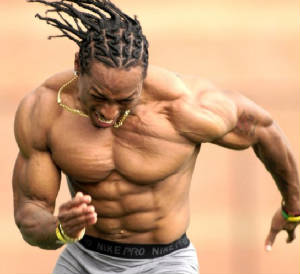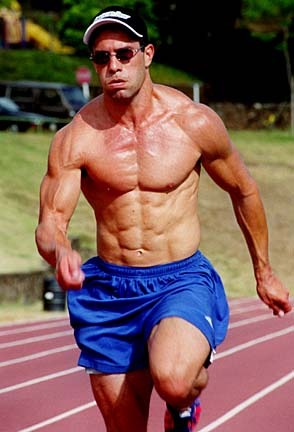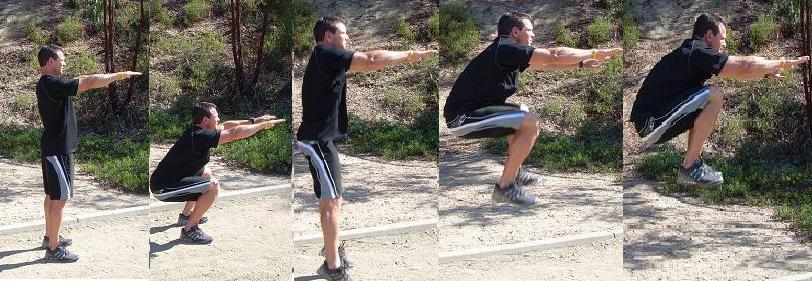|
So you want to be a gladiator. To be a successful MMA fighter takes
a lot of dedication and hard work. You also have to have “all your ducks
in a row” so to speak… You have to fight well, you have to be strong, and you have to have conditioning. If you
can’t fight well you may want to think about another career other than the fight sport. If you fight well and are in
great condition, you may go very far until you run into an athlete who has all the tools you do but is stronger. If you fight
well and are strong hopefully you can put your opponents away quickly because without conditioning a longer fight will almost
certainly spell your downfall.

In an earlier article
we looked at some exercises MMA athletes should use in their training to help develop their game from a strength standpoint.
The article was called 7 Unconventional Weightlifting Exercises You Should Use In Your MMA Training. If you’re looking for
a few strength training exercises that will transition well into your MMA game, check it out. (Click here) to view the article. Today I want to talk about the conditioning training
for MMA. Even if your not an avid weightlifter, not to worry. This program will still benefit you because there are no weights
involved. I think conditioning is probably the most important aspect of a MMA fighter’s game. You can get by with not being the most technically sound fighter. You can also get by with not being the
strongest fighter. Without the right type of conditioning, you’ll be lucky to make it out of the first round. Why is
someone’s conditioning so important in the fight game? Think about how hard it is to perform everyday task when you
are very tired. Now think about trying to engage in an all out fight when you’re very tired. The better you prepare
your body for the physical effects the less of a toll it will take on your body and your performance. For this article we
are going to focus solely on cardiovascular conditioning and the MMA fighter.
What is cardiovascular conditioning?
Cardiovascular conditioning is the ability
of the cardiovascular system (the heart, lungs, blood, and veins) to pump blood and oxygenate it under certain amounts of
stress. The less the cardiovascular system has to perform under certain stresses the better the cardiovascular conditioning
is.

Understanding cardiovascular
conditioning types-
Take an average person and ask them to
run a marathon, they probably won’t do that well. However take a marathon runner and ask them to run a marathon and
I’m sure they will do well. This is not because the marathon runner is a better athlete but because the marathon runner
is more conditioned for the sport.
There are two main types of cardiovascular
conditioning. They are aerobic and anaerobic conditioning. Aerobic activity is prolonged activity of moderate intensity. Aerobic
activity tends to use more, slower twitch muscle fibers. Anaerobic activity is high intensity activity where greater performances
have to be generated in short durations. Anaerobic activity tends to use more,
fast twitch muscle fibers. Fast twitch muscle fibers are used more for explosive
movements. Anaerobic activity is the one we want to focus on for MMA conditioning.
Conditioning the MMA athletes cardiovascular system- MMA is mostly
an anaerobic activity because it has a lot of small burst of explosive movements followed by periods of less intense activity.
This is where things will vary from the “norm” of fight sport training.
It is widely believed to get into good cardio conditioning for a fight, one should run, and do lots of it. While this
method does build up cardio conditioning, you have to look at what type of cardio conditioning your building up. Are you building
aerobic capacity or anaerobic capacity? A lot of combat athletes feel their running should consist of long durations and long
distances. Do you know the biggest problem with this idea? The athlete is building up the wrong type of cardiovascular capacity.
Secondly this can also lead to overtraining and excess fatigue. Remember we said MMA is mostly anaerobic in activity but this
type of training is building up aerobic capacity. Not only is this detrimental to their goal, but they will also eventually
start to loose explosiveness, the very thing that is vital to their success. They end up gaining endurance but lose on explosiveness.
Well what do they do then? We established that running is good for the cardiovascular system. We have also established that
running long distances and durations is bad for their explosiveness. Well why not “split the pot”. We want to
run but not for long distances. Part of the answer-sprinting.

Sprinting is a good choice because it is a movement
that requires someone to generate big burst of power for short durations. Not only does this cause the body to work in an
anaerobic capacity but it also helps build explosiveness because you have to explode out of the start of your sprint. Right
now you are probably thinking “Cool I’ll start sprinting tomorrow!” Well not so fast, remember I said part
of the answer. While we would do an adequate job of building up the cardiovascular system, what about the muscles? The thing about anaerobic activity is not only does the cardio vascular system have to be built up but
the muscular system also needs to be built up. Anaerobic activity requires the muscles to do tremendous work in short periods
of time. This builds up lactic acid. Have you have ever worked out hard and felt a burning sensation in your muscles? That
burning sensation is due to lactic acid. Too much lactic acid build up will simply cause the muscles to shut down. Imagine
being in the middle of a fight and you go to throw a punch but can’t cause you have too much lactic acid build up! ”
Well how would we fix that?” you ask. We fix this by incorporating explosive muscle pumping techniques with your sprints.
Plyometrics- We now know what we need as far as building explosiveness,
building, cardio conditioning, but now we have to add muscle conditioning. We want something easy that can be done with our
sprints. While some type of weight training would be good, most likely sprints will be done outdoors or somewhere where bringing
weights might not be the easiest thing. The solution is to use bodyweight exercises and plyometric type movements. Plyometrics
are great for explosive power training. Not only do plyometrics build up explosive power in muscles but also train the central
nervous system to adapt to stress.
Inducing the pump-
Okay, so we have the cardiovascular part,
the explosive part but what about building a pump. After all if we can’t handle a good amount of lactic acid in the
muscles how are they going to perform? This is probably the easiest part of the mix. After this amount of work a few moderate
rep bodyweight exercises should do the trick. For our program we are going to use bodyweight squats and pushups. They are
two very simple but effective exercises that can really induce a good pump with just using your body.
Putting it all together-
Now that we have all our parts lets put
it together for our explosive cardio training program. We have our sprints, our plyometrics, and our bodyweight exercises
for building the pump and lactic acid tolerance. The conditioning is the main part so we will sprint first. Secondly we want
to continue to build the explosiveness so we will place the plyometric work second. Finally we need our muscles to be able
to handle being pumped and lactic acid builds up when we are tired so that will be the last part, after we are tired from
everything else.
(The Program-)
The first week we are going to start with
a set of ten repetitions. We also want to increase work capacity each week, so each week we add one more sprint set to group.
So by week six you set total should be 16 repetitions per set. We want to do these four times a week, every other day. If
you started on a Monday, your workouts would be Monday, Wednesday, Friday, and Sunday. The next week you would just continue
on Tuesday, Thursday, Saturday, and begin Monday again the following week.
Your running distance should be somewhere
between 50 and 100 meters. For those of you who don’t follow the metric system that is between 164 and 328 feet. If
you’re a beginner or newer sprinter I recommend starting with a shorter distance and eventually working your way up
to the 100 meters.
Your workload is going to be as such:


- Immediately
after do 6 clap push ups

- Immediately after do 20 deep bodyweight squats

- Immediately after do 15 regular pushups

Once
you have completed everything that is one rep. While the program looks quite simple it is harder than it looks. You may be
only doing a total of five exercises but you will get great explosive cardiovascular benefits from it. If your looking for
a way to increase your cardio capacity while improving your explosiveness and the ability of your muscles to work under fatigue,
why not give it a try!
|

